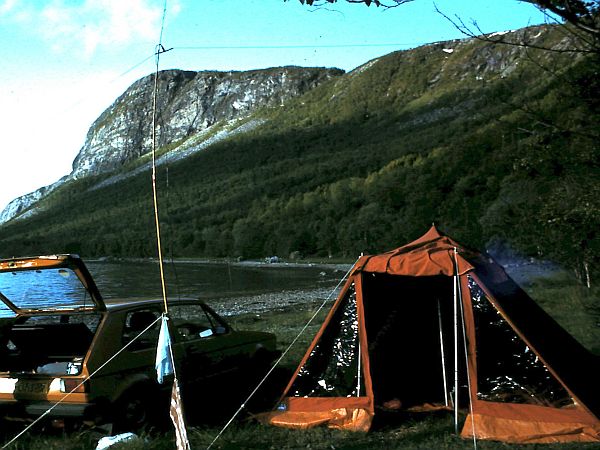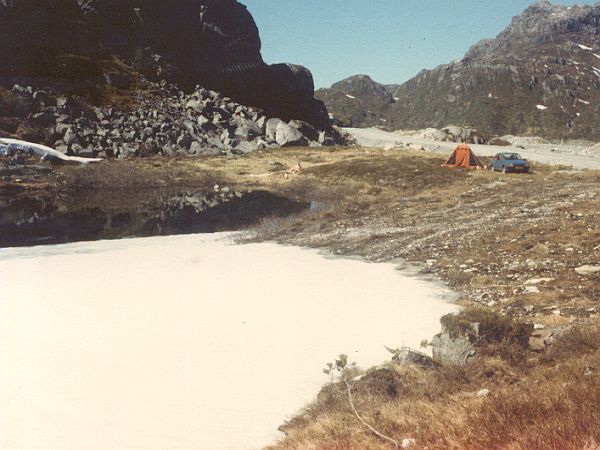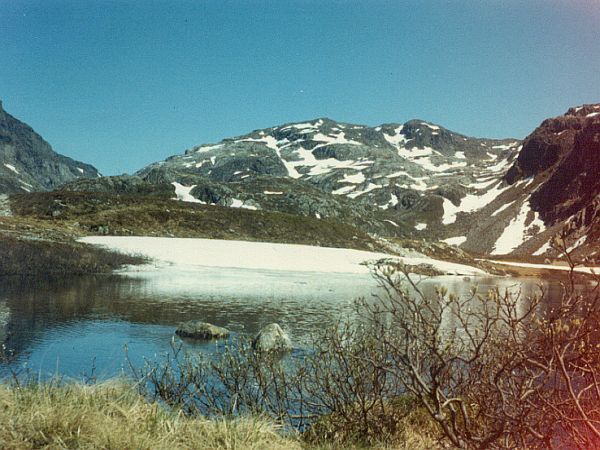MY FIRST QRP RIG "THE BAREFOOTER"
(1979)
KLIK HIER VOOR DE NEDERLANDSE VERSIE
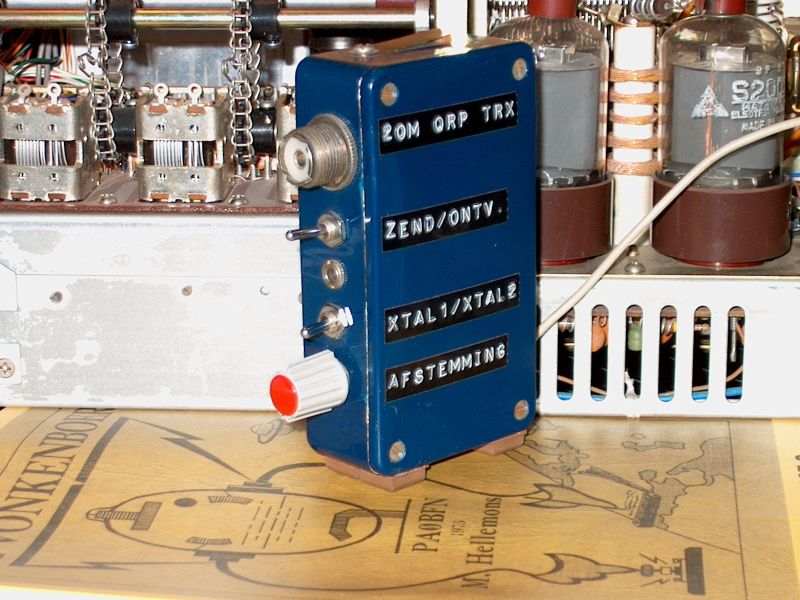
An ultra portable QRP CW-transceiver for 20 meter.
Holidays in Norway and Sweden with the simple QRP transceiver!
When I found the design, I could not believe that it was possible to make QSO's with it as its simplicity is such a huge contrast with the usual amateur transceivers with high power, superhet receiver and other complex circuits. But it should be a very nice experiment to take such a simple transceiver with me on holidays to Norway and Sweden!
Within two weeks this 20m QRP rig was ready to take with me on holidays to Norway and Sweden. And the results were astonishing! Almost every day it was possible to make a QSO with a radio amateur living nearby my home QTH. With ease, also a lot of other QSO's were made. Although I was just a starting radio amateur and the direct conversion receiver does not have much selectivity, I did not have any difficulties with the reception of the other station with a power of 100 watt. But when it should have been a QRP station, that would certainly be a problem! Unbelievable that you can make a QSO over such a distance with such simple equipment. And that while you are barefoot on a very isolated place in the magnificent nature. With nothing more than a very simple antenna and the Barefooter QRP rig with 4 transistors and 1 IC and two batteries!
As this simple rig worked much better than expected, I also made a two band version for 40 and 20m. And when the 30 meter band became available, also a version for this band was made.
Camping and working QRP portable with the simple Barefooter QRP transceiver at such nice places in nature!
What do you want more...
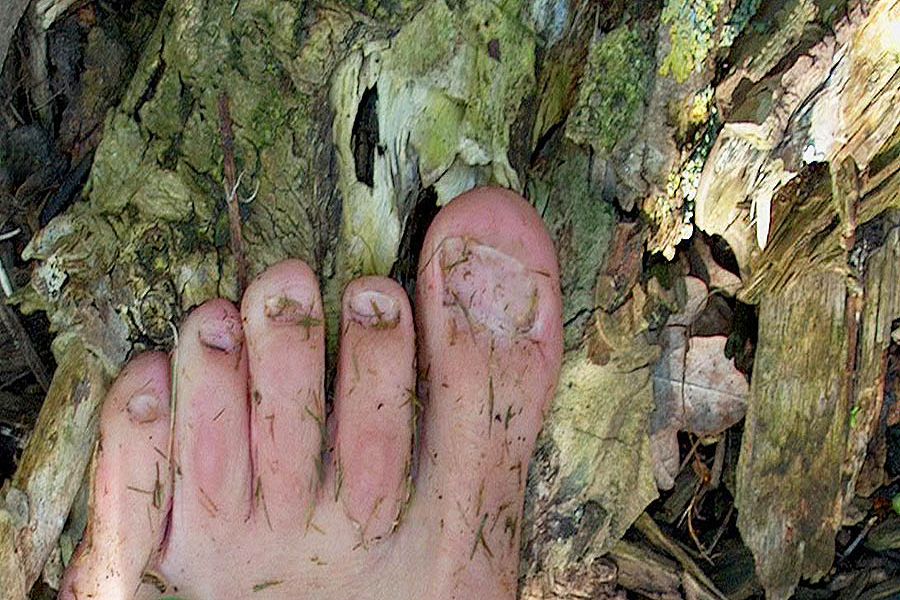
QRP Portable with ice cold red toes in the ice cold forest!
A portable station on bare feet!
Due to the barefooter QRP transceiver I did walk barefoot in the woods and in the snow during working portable and when camping in the free nature! As on a camping in the beginning of our holidays, I showed my small QRP transceiver with Barefoot Power to a few boys. One of them told that he did like to walk barefoot in the woods and even in the snow when it is not colder than -3C. And we got a nice idea. Back to basic! A very primitive portable station on bare feet without thick walking shoes! Which nice places in nature can you reach with just your bare feet? And can you make QSO's over there with that very simple transceiver and a very simple antenna? Exciting and challenging!
And QRP Portable on bare feet in the snow!
Portable in the woods
For the first time camping in the deserted woods instead of a safe camping! Nobody to see, all alone. Exciting! The only contact with the outer world is possile with the portable station on bare feet! Great! For the first time on bare feet! How cold! Horrible, although... I did feel the branches and stones quite well, but they were much to our suprise not too painful. First put down your toes, then your heels, that does walk already much better! During half an hour I did walk barefoot in the woods without real problems and I did find a good place to work portable.
Hanging up the antenna was so difficult that I even forgot that I did go barefoot in the woods! As branches and trees are very suitable to hang up an antenna, but they are also in the way when pulling up the antenna! The simple transceiver was connected to the antenna and batteries and a wonderful orchestra of CW signals could be heard. Making the QSO with The Netherlands was often difficult, not only because of the bad radiation in the woods, but also due to the many stations on- and nearby the frequency. When after a few repetitions, all the information was exchanged, I really had a feeling of victory!
Walking barefoot in the woods was much nicer, challenging and more active than with shoes! It was a great new experience and very nice to feel where you are walking! Despite the cold, sharp branches and stones, I did walk barefoot in nature during the whole evening. And that was so nice, that I would do that more often! Portable in the woods, on bare feet it was nuch nicer, challenging and more active than with shoes on! Although, sometimes a thorn had to be removed...
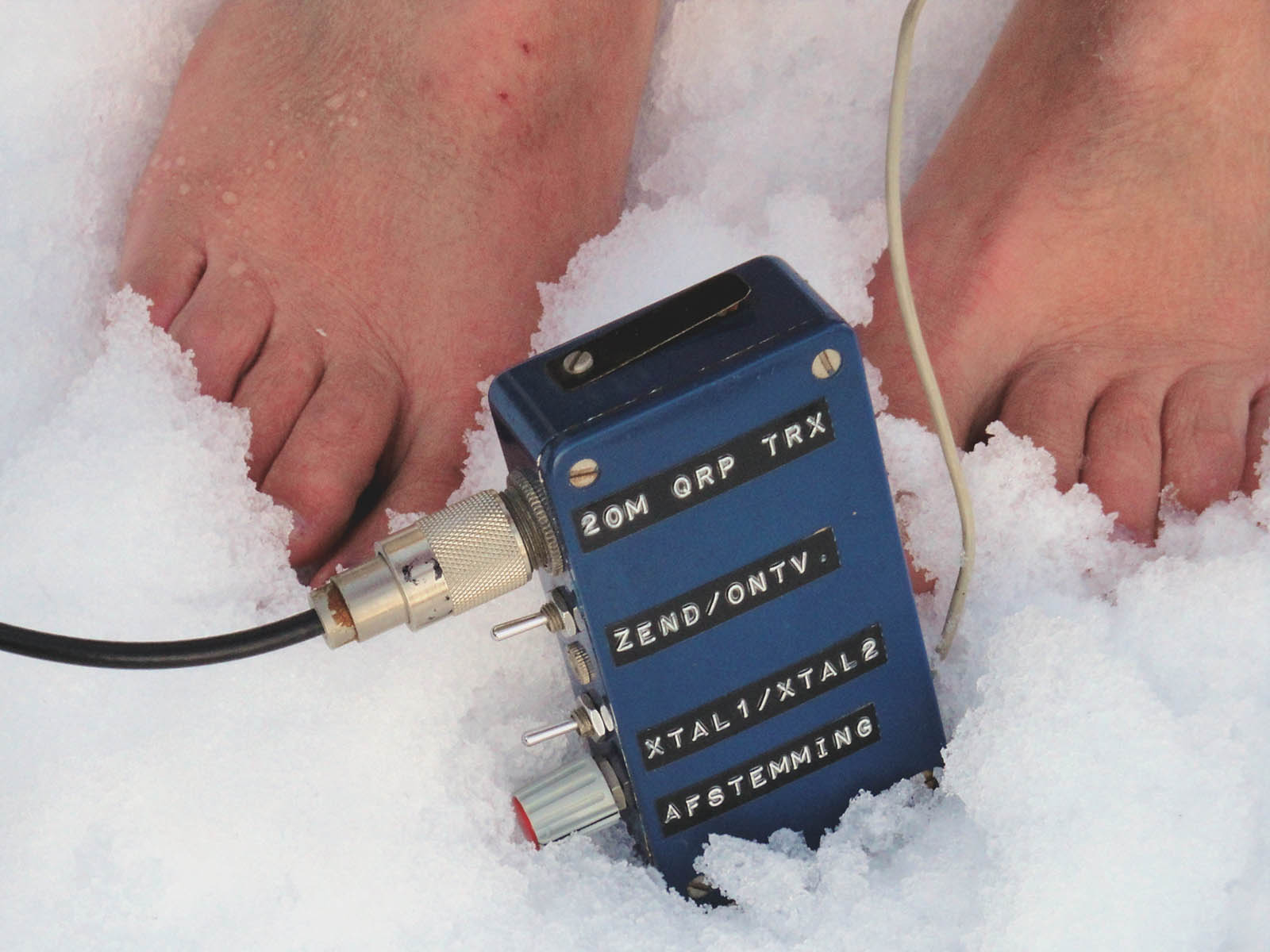
Of course I got cold bare feet and ice cold red toes while working portable in the snow!
Portable in the snow!
And then we came in the north in a rough, cold winterlandscape! It was a huge challenge to camp and to work portable here on bare feet! Thick
winter clothes, gloves and ... barefoot in this freezing cold winter landscape! Unbearable cold, I thought that I was dying! But quite soon that unbearable feeling disappeared. Then it suddenly felt as if I could walk barefoot to the North Pole. Setting up the vertical
antenna on the ice with snow was difficult. Funny those cold red bare feet in the white snow and on the ice! The batteries were kept warm under my clothes. And... three normal standard QSO's were made with 57 reports. At the end of the third QSO the vertical antenna did fall over. I did walk another hour barefoot on the ice and then it was time to go to the warm tent. My bare feet had survived the cold!!!
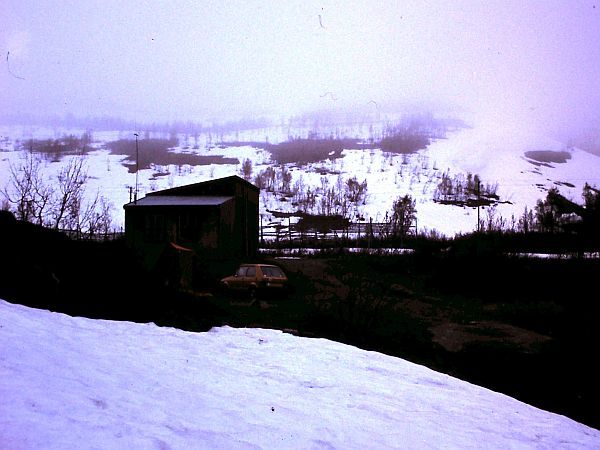
And then we came in the north in a rough, cold winterlandscape!
It was a huge challenge to camp and work portable here on bare feet!
Portable on the snowy mountain top!
Sometimes I did even totally forget that I did walk barefoot in the snow! As after a few times, getting used to the cold became much easier and then I did not understand anymore why that was so unbearable cold the first times! And then it was time for the sked. I wanted to climb the snowy mountain slope on my bare feet. And... with success!!! The vertical antenna did perform excellent! Good signals, not a word was missed. Only at the end of the QSO a QRO station came suddenly on the frequency. You cannot blame him for that, at that time, everyone was working with at least 100 watts and there were almost no weak QRP signals. Incredible! Far from home while standing barefoot with ice cold red toes in the snow it was very easy to make a QSO to The Netherlands with the simple battery-operated QRP transceiver and homemade antenna! Portable in the snow, on bare feet it was much nicer, more challenging and more active than with shoes on! Although, in the beginning really unbearable cold, later not anymore! My bare feet and toes became really freezing cold in the snow! But it was fun
to experience how my bare feet were still able to adapt to the cold. Energy was flowing in my bare feet and therefore also in my body. And on bare feet I could walk through the melting water to work portable somewhere!
Barefoot in the snow during holidays in Norway and Sweden.
Unusual and ice cold in the beginning but funny and nice later.
Beautiful holidays!
Holidays in Norway and Sweden, what a difference with the crowded campings, bars, restaurants and souvenir shops during my other holidays! Walking with thick walking shoes but also barefoot in the free nature without barbed wire and signs for forbidden access. Barefoot for the challenge and the back to nature sensation. To feel with your bare feet, we modern people do not do that anymore!
Nobody to see, a whole forest for us! Pure freedom and life in nature, a great experience. Camping barefoot on very isolated places in the nature, the huge forests and even in the snow was very special. Without luxurious amenities, with water from the stream. That gives an unknown sense of freedom, simplicity, back to basics and a great closeness to nature. There are many good and spacious campings where we were going so now and then to take a shower. But camping in the free nature is much nicer of course!
MY FIRST QRP RIG
The design is based on an article in the book Solid State Design for the Radio Amateur
In fact I do not need to explain everything in detail, just look at the schematic diagram and you will recognize most items. The VXO is used as the local oscillator for the direct conversion receiver and drives the final amplifier when transmitting.
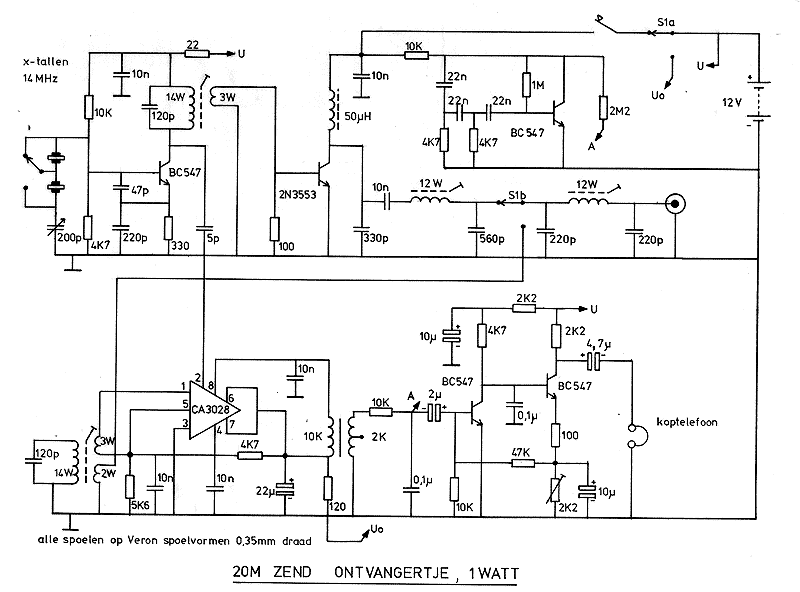
Circuit diagram, sorry for the Dutch language.
big diagram
Mixer
The mixer is an old chip, the CA3028. There are better and cheaper one's like the NE612. As the mixer is not balanced, the receiver is sensitive for AM detection of strong broadcast stations.
LF amplifier
The coupling between the two transistor LF amplifier and the mixer is via a LF transformer. And that is a problem if you use the rig nearby power lines or transformers, a loud 50 Hz hum is heard. I took a LF driver transformer of a balanced final LF amplifier from an old transistor radio.
The two transistor LF amplifier drives the headphones. Connect both earpieces in series instead of in parallel for much more audio output.
During transmission, the side tone generator is coupled via the 2M2 resistor (select the value for the side tone level you want to have) to the LF amplifier. Although there is not so much selectivity, the receiver sounds good and I always listened to it with pleasure. The 2k2 potentiometer is for the battery-empty indication. Connect the rig to the minimum supply voltage. While transmitting, adjust the potentiometer so that the side tone disappears.
VXO
The VXO frequency is varied by a simple variable mica capacitor. Via the 5 pFcapacitor, the VXO signal is fed to the mixer.
I used two crystals: 14045 and 14060 kHz, but of course you can use any frequency you like.
For the two band version, the 120 pF capacitor is removed and the tuneable coil is replaced by a FT37-43 ferrite core (same windings) and I use only one crystal per band.
Transmitter part
The VXO signal is amplified to 1 watt by a transistor 2N3553. The output is filtered in two pi sections. Why is switch S1b in the middle of the filter instead
of at the end? I really do not know. In the two band version I used two 5 pole filters and switch S1b at the end of the filters. Solder a 100 pF capacitor between the collector and emitter of the 2N3553 for stability reasons.
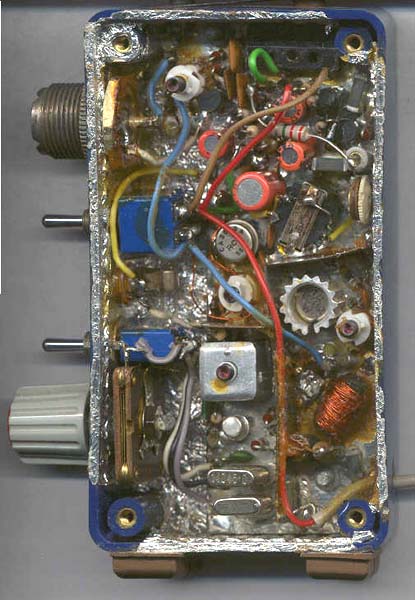
The inside view, all "Simple QRP" technology.
Notes
The CW key is a simple microswitch. When you see the photo's, you do not need a further explanation. In the 2 band version, I used an extra PNP transistor, so that the key is connected to ground.
The two earpieces of the headphone are connected in series instead of in parallel for more audio.
For the two band version, I also added a 1k potentiometer between S1b and the receiver for RF volume control.
Performance
I had a lot of fun with this rig and used it during holidays under all kinds of conditions. It always worked good!
The receiver is sensitive enough, some AM detection of strong broadcast stations is possible, the audio transformer gave problems when camping close to overhead power lines, there is no volume control, but it was real fun to use this rig. The antenna was a dipole between trees or as inverted V, the middle at 4 meters using a 5m fishing rod as a support. I also used a vertical (vertical wire mounted to the vertical fishing rod and 6 radials of 2 m length).
The rig was also used in the shack with a long wire antenna and a tuning unit. Many perfect QSO's are made, even long chats.
I also designed a new version, the 4 band HappyHoliday trx, you can find a description of it somewhere on this site.
RX current: 30 mA (quite high)
Transmit power: 0.6 W at 9 V; 1.5 W at 12 V
Harmonic suppression: Yes!
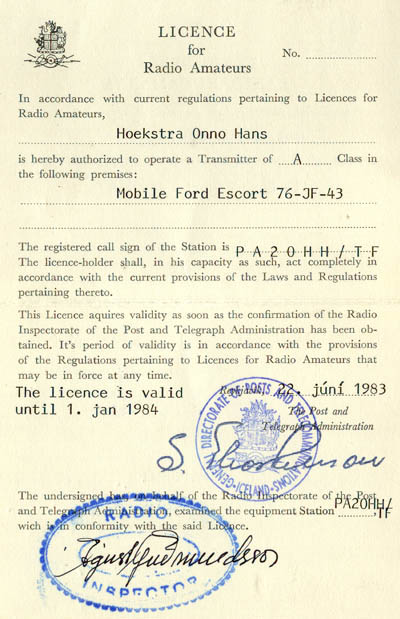
The licence for Island in 1983..
Paperwork and customs
At that time, you needed a license for each country. I did that always for the countries where I was QRV: Denmark, Norway, Sweden and Island. But they never were interested in the QRP transceivers and licences. There was another object, everyone was looking at it very suspiciously: the fishing rod used for the antenna! Fishing is illegal everywhere and if you should do that, they will kill you! Very often I had to explain that I did use that fishing rod only for the antenna and not for fishing!
Kamperen en QRP portable met de eenvoudige Barefooter QRP transceiver op zulke mooie plaatsen in de natuur!
Wat kun je nog meer wensen...
QRP practice
And then you are standing barefoot in the pricking thistles. The antenna connected, the sked was successfull and then you want to work a couple of other stations. Calling CQ but no answer. Again with your bare feet in the prickling thistles to change the antenna direction, calling CQ and again no answer. So the antenna direction was not the problem. Normally you do give up and you are convinced that QRP does not work. But I did read some extra radio books.
Indeed, calling CQ with a QRP signal does only work around the QRP frequencies, mention also that you are QRP. But with QRP, you have to do it differently. Answer a CQ calling station instead of calling CQ yourself. That does work already much better, except when also stronger stations are answering. Then you have to loose of course. Whan also works is calling a station after the end or a QSO. Mostly they will come back for you.
The next day on bare feet in the snow on the mountain I could try out the new practice. And now I could make QSO's. Suddenly QRP was nice and I continued till my ice cold toes were half frozen in that cold snow. And the batteries that were kept warm under the thick coat were empty.
Portable on bare feet in the ice cold forest was an exciting, nice challenge!
How much fun can you have with such a cheap and simple portable station on bare feet!
Not only to feel branches and stones, but also to feel the cold was something I really had to get used to.
Controlling the Barefooter
When you switch from transmit to receive, you have to retune the VXO a little, otherwise your receiver is zero beat with the other station. We want to keep this offset tuning as small as possible. Therefore, the other station will be heard with a low frequency audio tone. Just before the end of the transmission of the other station, we have to tune zero beat to be able to transmit on the exact frequency. If you should forget that, you will be heard most of the time when the offset is small. But there is another important reason: 400 Hz is not the most sensitive frequency of the ear but indeed the most selective frequency!
Antennas
The antenna was a dipole between the trees when camping in the woods. Stones were used to throw the ropes and antenna wires over the branches. Or the same dipole was used as inverted V with the center at 4 meters using a fishing rod as a support. Also a quarter wave vertical, using the same fishing rod with 6 wires of 2meters radial wires as groundplane was used.
All antenna's worked well, I never had an SWR meter with me. The vertical with the radials was made from loudspeaker wire and a PL259 plug, sold in a local shop in Sweden. The wire length was calculated and I never verified the SWR...
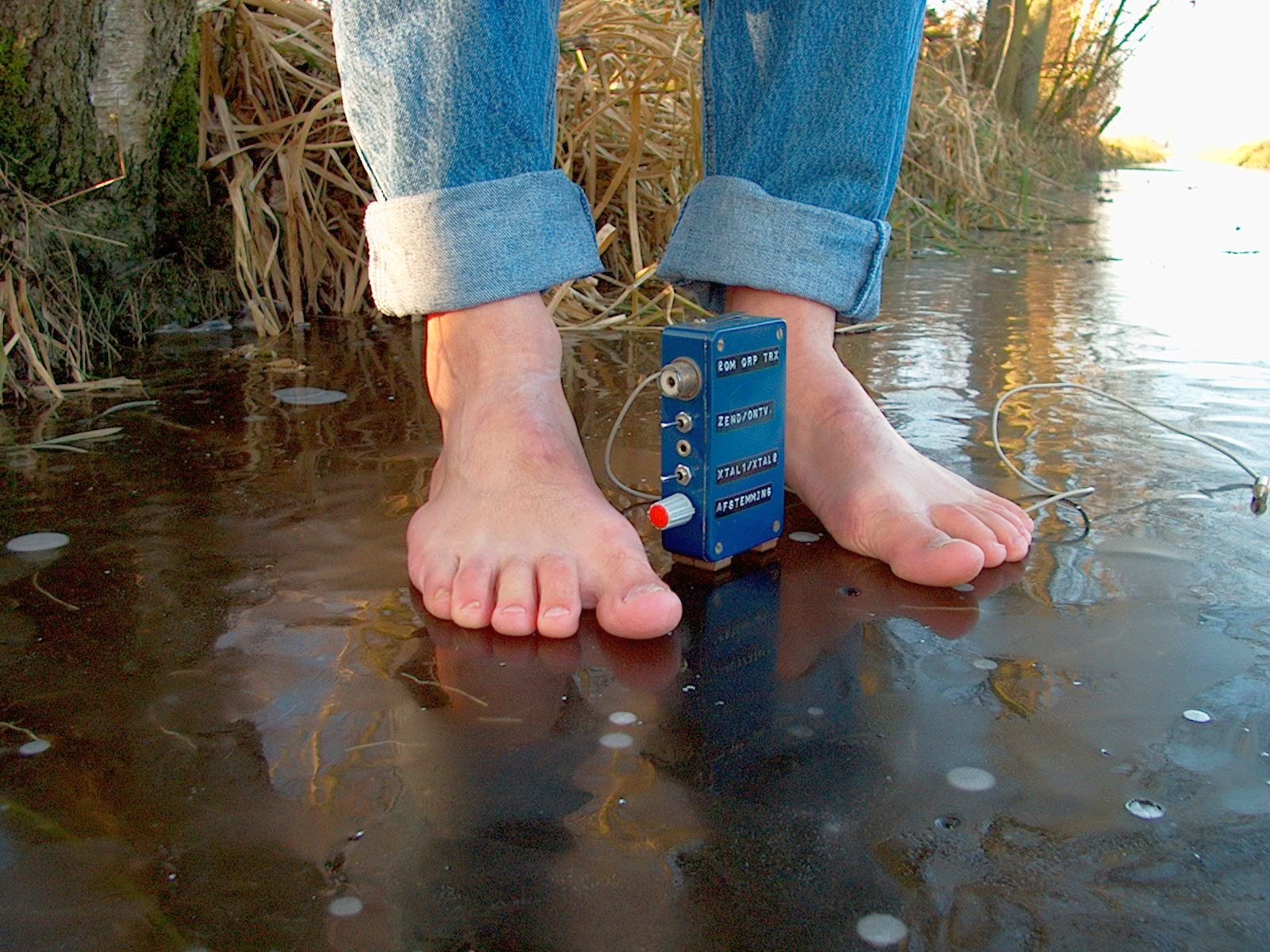
Portable barefoot on the ice for two hours was very challenging and intense!
But never try that when it's colder than -3C to -4C (26F)!
Portable barefoot on the ice!
It was winter, there was ice on the ditches. Paul thought I should try it... With thick winter clothes, going outside with my portable QRP station on bare feet! Everyone walked there with warm winter boots and warm socks! And me barefoot on the ice!
The first ten minutes barefoot on the ice were unbearably cold! Far too cold for my bare feet and my toes were nowhere near able to withstand the horrific cold. But I knew it, don't give up, because after a few minutes that unbearably cold feeling diminishes! And indeed, after about 10 minutes it was very intense but no longer unbearably cold for my bare feet. My toes were terribly cold. I was afraid my toes would freeze. They were somewhat numbed by the cold, but as long as they are red they do not freeze. Great, I managed to walk barefoot on the ice! After those first 10 minutes it was much better than expected! It was very intense and challenging and wonderful to feel the cold ice with my bare feet and to experience how my bare feet and especially my vulnerable toes react to this extreme cold. Will my poor toes give out? Will I get inflamed toe joints or blisters on my toes? We shall see. Because I wanted to work portable for two hours with my bare feet on the ice.
And it worked! Two hours portable barefoot on the ice! Five QSOs were made, two long ones! And then I walked barefoot very long on the ice. No, I did not need warm socks and shoes. In fact, I didn't want that anymore, it was a wonderful, unique experience to walk barefoot on the ice! And... no blisters or inflamed toe joints, nothing at all!
Very often I still worked portable barefoot in the snow and on the ice at home. With others who had warm shoes and socks! Those ice-cold bare feet with red toes in the snow and on the ice, some people find that horrifying to see, others find it very funny! Portable just barefoot, great, very challenging and intense!
But never try that when it's colder than -3C to -4C (26F)!!!
Index PA2OHH



